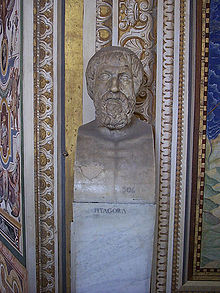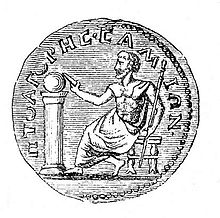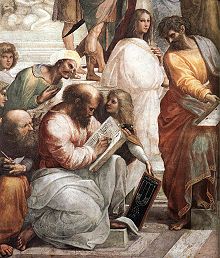- Pythagoras
-
"Pythagoras of Samos" redirects here. For the Samian statuary, see Pythagoras (sculptor).For other uses, see Pythagoras (disambiguation).
Pythagoras (Πυθαγόρας) 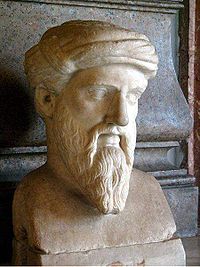
Bust of Pythagoras of Samos in the Capitoline Museums, RomeFull name Pythagoras (Πυθαγόρας) Born c. 570 BC
Samos IslandDied c. 495 BC (aged around 75)
MetapontumEra Ancient philosophy Region Western philosophy School Pythagoreanism Main interests Metaphysics, Music, Mathematics, Ethics, Politics Notable ideas Musica universalis, Golden ratio[citation needed], Pythagorean tuning, Pythagorean theorem Influenced by- Thales, Anaximander, Pherecydes
InfluencedPythagoras of Samos (Ancient Greek: Ὁ Πυθαγόρας ὁ Σάμιος Ho Pythagóras ho Sámios "Pythagoras the Samian", or simply Ὁ Πυθαγόρας; c. 570–c. 495 BC[1]) was an Ionian Greek philosopher, mathematician, and founder of the religious movement called Pythagoreanism. Most of the information about Pythagoras was written down centuries after he lived, so very little reliable information is known about him. He was born on the island of Samos, and might have travelled widely in his youth, visiting Egypt and other places seeking knowledge. He had a teacher named Themistoclea, who introduced him to the principles of ethics.[2][3] Around 530 BC, he moved to Croton, a Greek colony in southern Italy, and there set up a religious sect. His followers pursued the religious rites and practices developed by Pythagoras, and studied his philosophical theories. The society took an active role in the politics of Croton, but this eventually led to their downfall. The Pythagorean meeting-places were burned, and Pythagoras was forced to flee the city. He is said to have ended his days in Metapontum.
Pythagoras made influential contributions to philosophy and religious teaching in the late 6th century BC. He is often revered as a great mathematician, mystic and scientist, but he is best known for the Pythagorean theorem which bears his name. However, because legend and obfuscation cloud his work even more than with the other pre-Socratic philosophers, one can give account of his teachings to a little extent, and some have questioned whether he contributed much to mathematics and natural philosophy. Many of the accomplishments credited to Pythagoras may actually have been accomplishments of his colleagues and successors. Whether or not his disciples believed that everything was related to mathematics and that numbers were the ultimate reality is unknown. It was said that he was the first man to call himself a philosopher, or lover of wisdom,[4] and Pythagorean ideas exercised a marked influence on Plato, and through him, all of Western philosophy.
Contents
Biographical sources
Accurate facts about the life of Pythagoras are so few, and most information concerning him is of so late a date, and so untrustworthy, that it is impossible to provide more than a vague outline of his life. The lack of information by contemporary writers, together with the secrecy which surrounded the Pythagorean brotherhood, meant that invention took the place of facts. The stories which were created were eagerly sought by the Neoplatonist writers who provide most of the details about Pythagoras, but who were uncritical concerning anything which related to the gods or which was considered divine.[5] Thus many myths were created – such as that Apollo was his father; that Pythagoras gleamed with a supernatural brightness; that he had a golden thigh; that Abaris came flying to him on a golden arrow; that he was seen in different places at one and the same time.[6] With the exception of a few remarks by Xenophanes, Heraclitus, Herodotus, Plato, Aristotle, and Isocrates, we are mainly dependent on Diogenes Laërtius, Porphyry, and Iamblichus for the biographical details. Aristotle had written a separate work on the Pythagoreans, which unfortunately has not survived.[7] His disciples Dicaearchus, Aristoxenus, and Heraclides Ponticus had written on the same subject. These writers, late as they are, were among the best sources from whom Porphyry and Iamblichus drew, besides the legendary accounts and their own inventions. Hence historians are often reduced to considering the statements based on their inherent probability, but even then, if all the credible stories concerning Pythagoras were supposed true, his range of activity would be impossibly vast.[8]
Life
Herodotus, Isocrates, and other early writers all agree that Pythagoras was born on Samos, the Greek island in the eastern Aegean, and we also learn that Pythagoras was the son of Mnesarchus.[9] His father was a gem-engraver or a merchant. His name led him to be associated with Pythian Apollo; Aristippus explained his name by saying, "He spoke (agor-) the truth no less than did the Pythian (Pyth-)," and Iamblichus tells the story that the Pythia prophesied that his pregnant mother would give birth to a man supremely beautiful, wise, and beneficial to humankind.[10] A late source gives his mother's name as Pythais.[11] As to the date of his birth, Aristoxenus stated that Pythagoras left Samos in the reign of Polycrates, at the age of 40, which would give a date of birth around 570 BC.[12]
It was natural for the ancient biographers to inquire as to the origins of Pythagoras' remarkable system. In the absence of reliable information, however, a huge range of teachers were assigned to Pythagoras. Some made his training almost entirely Greek, others exclusively Egyptian and Oriental. We find mentioned as his instructors Creophylus,[13] Hermodamas,[14] Bias,[13] Thales,[13] Anaximander,[15] and Pherecydes of Syros.[16] The Egyptians are said to have taught him geometry, the Phoenicians arithmetic, the Chaldeans astronomy, the Magians the principles of religion and practical maxims for the conduct of life.[17] Of the various claims regarding his Greek teachers, Pherecydes is mentioned most often.
Diogenes Laertius reported that Pythagoras had undertaken extensive travels, and had visited not only Egypt, but Arabia, Phoenicia, Judaea, Babylon, and even India, for the purpose of collecting all available knowledge, and especially to learn information concerning the secret or mystic cults of the gods.[18] Plutarch asserted in his book On Isis and Osiris that during his visit to Egypt, Pythagoras received instruction from the Egyptian priest Oenuphis of Heliopolis.[19] Other ancient writers asserted his visit to Egypt.[20] Enough of Egypt was known to attract the curiosity of an inquiring Greek, and contact between Samos and other parts of Greece with Egypt is mentioned.[21]
It is not easy to say how much Pythagoras learned from the Egyptian priests, or indeed, whether he learned anything at all from them. There was nothing in the symbolism which the Pythagoreans adopted which showed the distinct traces of Egypt. The secret religious rites of the Pythagoreans exhibited nothing but what might have been adopted in the spirit of Greek religion, by those who knew nothing of Egyptian mysteries. The philosophy and the institutions of Pythagoras might easily have been developed by a Greek mind exposed to the ordinary influences of the age. Even the ancient authorities note the similarities between the religious and ascetic peculiarities of Pythagoras with the Orphic or Cretan mysteries,[22] or the Delphic oracle.[23]
There is little direct evidence as to the kind and amount of knowledge which Pythagoras acquired, or as to his definite philosophical views. Everything of the kind mentioned by Plato and Aristotle is attributed not to Pythagoras, but to the Pythagoreans. Heraclitus stated that he was a man of extensive learning;[24] and Xenophanes claimed that he believed in the transmigration of souls.[25] Xenophanes mentions the story of his interceding on behalf of a dog that was being beaten, professing to recognise in its cries the voice of a departed friend. Pythagoras is supposed to have claimed that he had been Euphorbus, the son of Panthus, in the Trojan war, as well as various other characters, a tradesman, a courtesan, etc.[26]
Many mathematical and scientific discoveries were attributed to Pythagoras, including his famous theorem,[27] as well as discoveries in the field of music,[28] astronomy,[29] and medicine.[30] But it was the religious element which made the profoundest impression upon his contemporaries. Thus the people of Croton were supposed to have identified him with the Hyperborean Apollo,[31] and he was said to have practised divination and prophecy.[32] In the visits to various places in Greece – Delos, Sparta, Phlius, Crete, etc. which are ascribed to him, he usually appears either in his religious or priestly guise, or else as a lawgiver.[33]
After his travels, Pythagoras moved (around 530 BC) to Croton, in Italy (Magna Graecia). Possibly the tyranny of Polycrates in Samos made it difficult for him to achieve his schemes there. His later admirers claimed that Pythagoras was so overburdened with public duties in Samos, because of the high estimation in which he was held by his fellow-citizens, that he moved to Croton.[34] On his arrival in Croton, he quickly attained extensive influence, and many people began to follow him. Later biographers tell fantastical stories of the effects of his eloquent speech in leading the people of Croton to abandon their luxurious and corrupt way of life and devote themselves to the purer system which he came to introduce.[35]
His followers established a select brotherhood or club for the purpose of pursuing the religious and ascetic practices developed by their master. The accounts agree that what was done and taught among the members was kept a profound secret. The esoteric teachings may have concerned the secret religious doctrines and usages, which were undoubtedly prominent in the Pythagorean system, and may have been connected with the worship of Apollo.[36] Temperance of all kinds seems to have been strictly urged. There is disagreement among the biographers as to whether Pythagoras forbade all animal food,[37] or only certain types.[38] The club was in practice at once "a philosophical school, a religious brotherhood, and a political association."[39]
Such an aristocratic and exclusive club could easily have made many people in Croton jealous and hostile, and this seems to have led to its destruction. The circumstances, however, are uncertain. Conflict seems to have broken out between the towns of Sybaris and Croton. The forces of Croton were headed by the Pythagorean Milo, and it is likely that the members of the brotherhood took a prominent part. After the decisive victory by Croton, a proposal for establishing a more democratic constitution, was unsuccessfully resisted by the Pythagoreans. Their enemies, headed by Cylon and Ninon, the former of whom is said to have been irritated by his exclusion from the brotherhood, roused the populace against them. An attack was made upon them while assembled either in the house of Milo, or in some other meeting-place. The building was set on fire, and many of the assembled members perished; only the younger and more active escaping.[40] Similar commotions ensued in the other cities of Magna Graecia in which Pythagorean clubs had been formed.
As an active and organised brotherhood the Pythagorean order was everywhere suppressed, and did not again revive. Still the Pythagoreans continued to exist as a sect, the members of which kept up among themselves their religious observances and scientific pursuits, while individuals, as in the case of Archytas, acquired now and then great political influence. Concerning the fate of Pythagoras himself, the accounts varied. Some say that he perished in the temple with his disciples,[41] others that he fled first to Tarentum, and that, being driven from there, he escaped to Metapontum, and there starved himself to death.[42] His tomb was shown at Metapontum in the time of Cicero.[43]
According to some accounts Pythagoras married Theano, a lady of Croton. Their children are variously stated to have included a son, Telauges, and three daughters, Damo, Arignote, and Myia.
Writings
No texts by Pythagoras are known to have survived, although forgeries under his name — a few of which remain extant — did circulate in antiquity. Critical ancient sources like Aristotle and Aristoxenus cast doubt on these writings. Ancient Pythagoreans usually quoted their master's doctrines with the phrase autos ephe ("he himself said") — emphasizing the essentially oral nature of his teaching.
Mathematics
The so-called Pythagoreans, who were the first to take up mathematics, not only advanced this subject, but saturated with it, they fancied that the principles of mathematics were the principles of all things.—Aristotle, Metaphysics 1–5 , cc. 350 BCPythagorean theorem
Since the fourth century AD, Pythagoras has commonly been given credit for discovering the Pythagorean theorem, a theorem in geometry that states that in a right-angled triangle the area of the square on the hypotenuse (the side opposite the right angle) is equal to the sum of the areas of the squares of the other two sides—that is, a2 + b2 = c2.
While the theorem that now bears his name was known and previously utilized by the Babylonians and Indians, he, or his students, are often said to have constructed the first proof. It must, however, be stressed that the way in which the Babylonians handled Pythagorean numbers implies that they knew that the principle was generally applicable, and knew some kind of proof, which has not yet been found in the (still largely unpublished) cuneiform sources.[44] Because of the secretive nature of his school and the custom of its students to attribute everything to their teacher, there is no evidence that Pythagoras himself worked on or proved this theorem. For that matter, there is no evidence that he worked on any mathematical or meta-mathematical problems. Some attribute it as a carefully constructed myth by followers of Plato over two centuries after the death of Pythagoras, mainly to bolster the case for Platonic meta-physics, which resonate well with the ideas they attributed to Pythagoras. This attribution has stuck down the centuries up to modern times.[45] The earliest known mention of Pythagoras's name in connection with the theorem occurred five centuries after his death, in the writings of Cicero and Plutarch.
Musical theories and investigations
See also: Pythagorean tuning and Pythagorean hammersAccording to legend, the way Pythagoras discovered that musical notes could be translated into mathematical equations was when one day he passed blacksmiths at work, and thought that the sounds emanating from their anvils being hit were beautiful and harmonious and decided that whatever scientific law caused this to happen must be mathematical and could be applied to music. He went to the blacksmiths to learn how this had happened by looking at their tools, he discovered that it was because the hammers were "simple ratios of each other, one was half the size of the first, another was 2/3 the size, and so on."
This legend has since proven to be false by virtue of the fact that these ratios are only relevant to string length (such as the string of a monochord), and not to hammer weight.[46][47] However, it may be that Pythagoras was indeed responsible for discovering these properties of string length.
Pythagoreans elaborated on a theory of numbers, the exact meaning of which is still debated among scholars. Another belief attributed to Pythagoras was that of the "harmony of the spheres". Thus the planets and stars moved according to mathematical equations, which corresponded to musical notes and thus produced a symphony.[48]
Tetractys
Pythagoras was also credited with devising the tetractys, the triangular figure of four rows, which add up to the perfect number, ten. As a mystical symbol, it was very important to the worship of the Pythagoreans, who would swear oaths by it:
And the inventions were so admirable, and so divinised by those who understood them, that the members used them as forms of oath: "By him who handed to our generation the tetractys, source of the roots of ever-flowing nature."—Iamblichus, Vit. Pyth., 29Religion and science
Pythagoras’ religious and scientific views were, in his opinion, inseparably interconnected. Religiously, Pythagoras was a believer of metempsychosis. He believed in transmigration, or the reincarnation of the soul again and again into the bodies of humans, animals, or vegetables until it became immortal. His ideas of reincarnation were influenced by ancient Greek religion. Heraclides Ponticus reports the story that Pythagoras claimed that he had lived four lives that he could remember in detail,[49] and, according to Xenophanes, Pythagoras heard the cry of his dead friend in the bark of a dog.[50]
Lore
Pythagoras became the subject of elaborate legends surrounding his historic persona. Aristotle described Pythagoras as a wonder-worker and somewhat of a supernatural figure, attributing to him such aspects as a golden thigh, which was a sign of divinity. According to Muslim tradition, Pythagoras was said to have been initiated by Hermes (Egyptian Thoth).[51] According to Aristotle and others' accounts, some ancients believed that he had the ability to travel through space and time, and to communicate with animals and plants.[52] An extract from Brewer's Dictionary of Phrase and Fable's entry entitled "Golden Thigh":
Pythagoras is said to have had a golden thigh, which he showed to Abaris, the Hyperborean priest, and exhibited in the Olympic games.[53]
Another legend describes his writing on the moon:
Pythagoras asserted he could write on the moon. His plan of operation was to write on a looking-glass in blood, and place it opposite the moon, when the inscription would appear photographed or reflected on the moon's disc.[54]
Pythagoreans
See also: PythagoreanismBoth Plato and Isocrates affirm that, above all else, Pythagoras was famous for leaving behind him a way of life.[55] Both Iamblichus and Porphyry give detailed accounts of the organisation of the school, although the primary interest of both writers is not historical accuracy, but rather to present Pythagoras as a divine figure, sent by the gods to benefit humankind.[56]
Pythagoras set up an organization which was in some ways a school, in some ways a brotherhood (and here it should be noted that sources indicate that as well as men there were many women among the adherents of Pythagoras),[57] and in some ways a monastery. It was based upon the religious teachings of Pythagoras and was very secretive. The adherents were bound by a vow to Pythagoras and each other, for the purpose of pursuing the religious and ascetic observances, and of studying his religious and philosophical theories. The claim that they put all their property into a common stock is perhaps only a later inference from certain Pythagorean maxims and practices.[58]
As to the internal arrangements of the sect, we are informed that what was done and taught among the members was kept a profound secret towards all. Porphyry stated that this silence was "of no ordinary kind." Candidates had to pass through a period of probation, in which their powers of maintaining silence (echemythia) were especially tested, as well as their general temper, disposition, and mental capacity.[59] There were also gradations among the members themselves. It was an old Pythagorean maxim, that every thing was not to be told to every body.[60] Thus the Pythagoreans were divided into an inner circle called the mathematikoi ("learners") and an outer circle called the akousmatikoi ("listeners").[61] Iamblichus describes them in terms of esoterikoi and exoterikoi (or alternatively Pythagoreioi and Pythagoristai),[62] according to the degree of intimacy which they enjoyed with Pythagoras. Porphyry wrote "the mathematikoi learned the more detailed and exactly elaborated version of this knowledge, the akousmatikoi (were) those who had heard only the summary headings of his (Pythagoras's) writings, without the more exact exposition."
There were ascetic practices (many of which had, perhaps, a symbolic meaning) in the way of life of the sect.[63] Some represent Pythagoras as forbidding all animal food, advocating a plant-based diet, and prohibiting consumption of beans. This may have been due to the doctrine of metempsychosis.[64] Other authorities contradict the statement. According to Aristoxenus,[65] he allowed the use of all kinds of animal food except the flesh of oxen used for ploughing, and rams.[66] There is a similar discrepancy as to the prohibition of fish and beans.[67] But temperance of all kinds seems to have been urged. It is also stated that they had common meals, resembling the Spartan system, at which they met in companies of ten.[68]
Considerable importance seems to have been attached to music and gymnastics in the daily exercises of the disciples. Their whole discipline is represented as encouraging a lofty serenity and self-possession, of which, there were various anecdotes in antiquity.[69] Iamblichus (apparently on the authority of Aristoxenus)[70] gives a long description of the daily routine of the members, which suggests many similarities with Sparta. The members of the sect showed a devoted attachment to each other, to the exclusion of those who did not belong to their ranks.[71] There were even stories of secret symbols, by which members of the sect could recognise each other, even if they had never met before.[72]
Influence
Influence on Plato
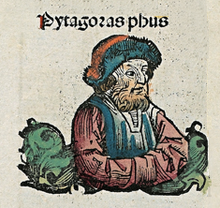 Pythagoras, depicted as a medieval scholar in the Nuremberg Chronicle
Pythagoras, depicted as a medieval scholar in the Nuremberg Chronicle
Pythagoras, or in a broader sense, the Pythagoreans, allegedly exercised an important influence on the work of Plato. According to R. M. Hare, this influence consists of three points: (1) The platonic Republic might be related to the idea of "a tightly organized community of like-minded thinkers", like the one established by Pythagoras in Croton. (2) There is evidence that Plato possibly took from Pythagoras the idea that mathematics and, generally speaking, abstract thinking is a secure basis for philosophical thinking as well as "for substantial theses in science and morals". (3) Plato and Pythagoras shared a "mystical approach to the soul and its place in the material world". It is probable that both were influenced by Orphism.[73]
Aristotle claimed that the philosophy of Plato closely followed the teachings of the Pythagoreans,[74] and Cicero repeats this claim: Platonem ferunt didicisse Pythagorea omnia ("They say Plato learned all things Pythagorean").[75] Bertrand Russell, in his A History of Western Philosophy, contended that the influence of Pythagoras on Plato and others was so great that he should be considered the most influential of all Western philosophers.
Influence on esoteric groups
Pythagoras started a secret society called the Pythagorean brotherhood devoted to the study of mathematics. This had a great effect on future esoteric traditions, such as Rosicrucianism and Freemasonry, both of which were occult groups dedicated to the study of mathematics and both of which claimed to have evolved out of the Pythagorean brotherhood. The mystical and occult qualities of Pythagorean mathematics are discussed in a chapter of Manly P. Hall's The Secret Teachings of All Ages entitled "Pythagorean Mathematics". [76] Pythagorean theory was tremendously influential on later numerology, which was extremely popular throughout the Middle East in the ancient world. The 8th-century Muslim alchemist Jabir ibn Hayyan grounded his work in an elaborate numerology greatly influenced by Pythagorean theory.[citation needed] Today, Pythagoras is revered as a prophet by the Ahl al-Tawhid or Druze faith along with his fellow Greek, Plato.
See also
- Pythagorean cup
- Pythagoras tree (fractal)
- Sacred geometry
- The golden verses of Pythagoras
- List of things named after Pythagoras
References
- ^ "The dates of his life cannot be fixed exactly, but assuming the approximate correctness of the statement of Aristoxenus (ap. Porph. V.P. 9) that he left Samos to escape the tyranny of Polycrates at the age of forty, we may put his birth round about 570 BC, or a few years earlier. The length of his life was variously estimated in antiquity, but it is agreed that he lived to a fairly ripe old age, and most probably he died at about seventy-five or eighty." William Keith Chambers Guthrie, (1978), A history of Greek philosophy, Volume 1: The earlier Presocratics and the Pythagoreans, page 173. Cambridge University Press
- ^ Mary Ellen Waithe, Ancient women philosophers, 600 B.C.–500 A.D., p. 11
- ^ Malone, John C. (30 June 2009). Psychology: Pythagoras to present. MIT Press. p. 22. ISBN 9780262012966. http://books.google.com/books?id=e6Qa6cMQj8AC&pg=PA22. Retrieved 25 October 2010.
- ^ Cicero, Tusculan Disputations, 5.3.8–9 = Heraclides Ponticus fr. 88 Wehrli, Diogenes Laërtius 1.12, 8.8, Iamblichus VP 58. Burkert attempted to discredit this ancient tradition, but it has been defended by C.J. De Vogel, Pythagoras and Early Pythagoreanism (1966), pp. 97–102, and C. Riedweg, Pythagoras: His Life, Teaching, And Influence (2005), p. 92.
- ^ Iamblichus, Adhort. ad Philos. p. 324, ed. Kiessling.
- ^ Comp. Herodian, iv. 94, etc.
- ^ He alludes to it himself, Met. i. 5. p. 986. 12, ed. Bekker.
- ^ This article incorporates text from the public domain Dictionary of Greek and Roman Biography and Mythology by William Smith (1870).
- ^ Herodotus, iv. 95, Isocrates, Busiris, 28–9; Later writers called him a Tyrrhenian or Phliasian, and gave Marmacus, or Demaratus, as the name of his father, Diogenes Laërtius, viii. 1; Porphyry, Vit. Pyth. 1, 2; Justin, xx. 4; Pausanias, ii. 13.
- ^ Riedweg, Christoph (2005). Pythagoras: His Life, Teaching and Influence. Cornell University. pp. 5–6, 59, 73.
- ^ Apollonius of Tyana ap. Porphyry, Vit. Pyth. 2
- ^ Porphyry, Vit. Pyth. 9
- ^ a b c Iamblichus, Vit. Pyth. 9
- ^ Porphyry, Vit. Pyth. 2, Diogenes Laërtius, viii. 2
- ^ Iamblichus, Vit. Pyth. 9; Porphyry, Vit. Pyth. 2
- ^ Aristoxenus and others in Diogenes Laërtius, i. 118, 119; Cicero, de Div. i. 49
- ^ Porphyry, Vit. Pyth. 6
- ^ Diogenes Laërtius, viii. 2; Porphyry, Vit. Pyth. 11, 12; Iamblichus, Vit. Pyth. 14, etc.
- ^ Plutarch, On Isis And Osiris, ch. 10.
- ^ Antiphon. ap. Porphyry, Vit. Pyth. 7; Isocrates, Busiris, 28–9; Cicero, de Finibus, v. 27; Strabo, xiv.
- ^ Herodotus, ii. 134, 135, iii. 39.
- ^ Iamblichus, Vit. Pyth. 25; Porphyry, Vit. Pyth. 17; Diogenes Laërtius, viii. 3
- ^ Ariston. ap. Diogenes Laërtius, viii. 8, 21; Porphyry, Vit. Pyth. 41
- ^ Diogenes Laërtius, viii. 6, ix. 1, comp. Herodotus, i. 29, ii. 49, iv. 95
- ^ Diogenes Laërtius, viii. 36, comp. Aristotle, de Anima, i. 3; Herodotus, ii. 123.
- ^ Porphyry, Vit. Pyth. 26; Pausanias, ii. 17; Diogenes Laërtius, viii. 5; Horace, Od. i. 28,1. 10
- ^ Diogenes Laërtius, viii. 12 ; Plutarch, Non posse suav. vivi sec. Ep. p. 1094
- ^ Porphyry, in Ptol. Harm. p. 213; Diogenes Laërtius, viii. 12
- ^ Diogenes Laërtius, viii. 14 ; Pliny, Hist. Nat. ii. 8
- ^ Diogenes Laërtius, viii. 12, 14, 32
- ^ Porphyry, Vit. Pyth. 20; Iamblichus, Vit. Pyth. 31, 140; Aelian, Varia Historia, ii. 26; Diogenes Laërtius, viii. 36.
- ^ Cicero, de Divin. i. 3, 46; Porphyry, Vit. Pyth. 29.
- ^ Iamblichus, Vit. Pyth. 25; Porphyry, Vit. Pyth. 17; Diogenes Laërtius, viii. 3, 13; Cicero, Tusc. Qu. v. 3
- ^ Iamblichus, Vit. Pyth. 28; Porphyry, Vit. Pyth. 9
- ^ Porphyry, Vit. Pyth. 18; Iamblichus, Vit. Pyth. 37, etc.
- ^ Aelian, Varia Historia, ii. 26; Diogenes Laërtius, viii. 13; Iamblichus, Vit. Pyth. 8, 91, 141
- ^ as Empedocles did afterwards, Aristotle, Rhet. i. 14. § 2; Sextus Empiricus, ix. 127. This was also one of the Orphic precepts, Aristoph. Ran. 1032
- ^ Aristo ap. Diogenes Laërtius, viii. 20; comp. Porphyry, Vit. Pyth. 7; Iamblichus, Vit. Pyth. 85, 108
- ^ Thirlwall, Hist. of Greece, vol. ii. p. 148
- ^ Iamblichus, Vit. Pyth. 255–259; Porphyry, Vit. Pyth. 54–57; Diogenes Laërtius, viii. 39; comp. Plutarch, de Gen. Socr. p. 583
- ^ Arnob. adv. Gentes, i. p. 23
- ^ Diogenes Laërtius, viii. 39, 40; Porphyry, Vit. Pyth. 56; Iamblichus, Vit. Pyth. 249; Plutarch, de Stoic. Rep. 37
- ^ Cicero, de Fin. v. 2
- ^ There are about 100,000 unpublished cuneiform sources in the British Museum alone. Babylonian knowledge of proof of the Pythagorean Theorem is discussed by J. Høyrup, 'The Pythagorean "Rule" and "Theorem" – Mirror of the Relation between Babylonian and Greek Mathematics,' in: J. Renger (red.): Babylon. Focus mesopotamischer Geschichte, Wiege früher Gelehrsamkeit, Mythos in der Moderne (1999).
- ^ From Christoph Riedweg , Pythagoras, His Life, Teaching and Influence, Cornell: Cornell University Press, 2005: "Had Pythagoras and his teachings not been since the early Academy overwritten with Plato’s philosophy, and had this ‘palimpsest’ not in the course of the Roman Empire achieved unchallenged authority among Platonists, it would be scarcely conceivable that scholars from the Middle Ages and modernity down to the present would have found the Presocratic charismatic from Samos so fascinating. In fact, as a rule it was the image of Pythagoras elaborated by Neopythagoreans and Neoplatonists that determined the idea of what was Pythagorean over the centuries."
- ^ Weiss, Piero, and Richard Taruskin, eds. Music in the Western World: A History in Documents. 2nd ed. N.p.: Thomson Schirmer, 1984. 3. Print.
- ^ Christensen, Thomas, ed. The Cambridge history of Western music theory. Cambridge: Cambridge University Press, 2002. 143. Print.
- ^ Christoph Riedweg, Pythagoras: His Life, Teaching and Influence, Cornell: Cornell University Press, 2005 .
- ^ Diogenes Laërtius, viii. 3–4
- ^ Diogenes Laërtius, viii. 36
- ^ See Antoine Faivre, in The Eternal Hermes (1995)
- ^ Huffman, Carl. Pythagoras (Stanford Encyclopedia of Philosophy)
- ^ Brewer, E. Cobham, Brewer's Dictionary of Phrase and Fable
- ^ Brewer, E. Cobham, Brewer's Dictionary of Phrase and Fable
- ^ Plato, Republic, 600a, Isocrates, Busiris, 28
- ^ John Dillon and Jackson Hershbell, (1991), Iamblichus, On the Pythagorean Way of Life, page 14. Scholars Press.; D. J. O'Meara, (1989), Pythagoras Revived. Mathematics and Philosophy in Late Antiquity, pages 35–40. Clarendon Press.
- ^ Porphyry, Vit. Pyth. 19
- ^ comp. Cicero, de Leg. i. 12, de Off. i. 7; Diogenes Laërtius, viii. 10
- ^ Aristonexus ap. Iamblichus, Vit. Pyth. 94
- ^ Diogenes Laërtius, viii. 15; Aristonexus ap. Iamblichus, Vit. Pyth. 31
- ^ Iamblichus, Vit. Pyth. 80, cf. Aulus Gellius, i. 9
- ^ Iamblichus, Vit. Pyth. 80
- ^ comp. Porphyry, Vit. Pyth. 32; Iamblichus, Vit. Pyth. 96, etc.
- ^ Plutarch, de Esu Carn. pp. 993, 996, 997
- ^ Aristoxenus ap. Diogenes Laërtius, viii. 20
- ^ comp. Porphyry, Vit. Pyth. 7; Iamblichus, Vit. Pyth. 85, 108
- ^ Diogenes Laërtius, viii. 19, 34; Aulus Gellius, iv. 11; Porphyry, Vit. Pyth. 34, de Abst. i. 26; Iamblichus, Vit. Pyth. 98
- ^ Iamblichus, Vit. Pyth. 98; Strabo, vi.
- ^ Athenaeus, xiv. 623; Aelian, Varia Historia, xiv. 18; Iamblichus, Vit. Pyth. 197
- ^ Iamblichus, Vit. Pyth. 96–101
- ^ Aristonexus ap. Iamblichus, Vit. Pyth. 94, 101, etc., 229, etc.; comp. the story of Damon and Phintias; Porphyry, Vit. Pyth. 60; Iamblichus, Vit. Pyth. 233, etc.
- ^ Scholion ad Aristophanes, Nub. 611; Iamblichus, Vit. Pyth. 237, 238
- ^ R.M. Hare, Plato in C.C.W. Taylor, R.M. Hare and Jonathan Barnes, Greek Philosophers, Socrates, Plato, and Aristotle, Oxford: Oxford University Press, 1999 (1982), 103–189, here 117–9.
- ^ Metaphysics, 1.6.1 (987a)
- ^ Tusc. Disput. 1.17.39.
- ^ Hall, Manly The Secrets Teaching of All Ages Tarcher Penguin 2003 pages 191–221.
Sources
Classical secondary sources
Only a few relevant source texts deal with Pythagoras and the Pythagoreans, most are available in different translations. Other texts usually build solely on information in these works.
- Diogenes Laërtius, Vitae philosophorum VIII (Lives of Eminent Philosophers), c. 200 AD, which in turn references the lost work Successions of Philosophers by Alexander Polyhistor —
 Life of Pythagoras, translated by Robert Drew Hicks (1925).
Life of Pythagoras, translated by Robert Drew Hicks (1925). - Porphyry, Vita Pythagorae (Life of Pythagoras), c. 270 AD — Porphyry, Life of Pythagoras, translated by Kenneth Sylvan Guthrie (1920)
- Iamblichus, De Vita Pythagorica (On the Pythagorean Life), c. 300 AD — Iamblichus, Life of Pythagoras, translated by Kenneth Sylvan Guthrie (1920)
- Apuleius also writes about Pythagoras in Apologia, c. 150 AD, including a story of him being taught by Babylonian disciples of Zoroaster
- Hierocles of Alexandria, Golden Verses of Pythagoras, c. 430 AD
Modern secondary sources
- Burkert, Walter. Lore and Science in Ancient Pythagoreanism. Harvard University Press, June 1, 1972. ISBN 0-674-53918-4
- Burnyeat, M. F. "The Truth about Pythagoras". London Review of Books, 22 February 2007.
- Guthrie, W. K. A History of Greek Philosophy: Earlier Presocratics and the Pythagoreans, Cambridge University Press, 1979. ISBN 0-521-29420-7
- Kingsley, Peter. Ancient Philosophy, Mystery, and Magic: Empedocles and the Pythagorean Tradition. Oxford University Press, 1995.
- Hermann, Arnold. To Think Like God: Pythagoras and Parmenides—the Origins of Philosophy. Parmenides Publishing, 2005. ISBN 978-1-930972-00-1
- O'Meara, Dominic J. Pythagoras Revived. Oxford University Press, 1989. ISBN 0-19-823913-0 (paperback), ISBN 0-19-824485-1 (hardcover)
External links
- Pythagoras on In Our Time at the BBC. (listen now)
- Pythagoras entry by Carl Huffman in the Stanford Encyclopedia of Philosophy
- Pythagoras of Samos, The MacTutor History of Mathematics archive, School of Mathematics and Statistics, University of St Andrews, Scotland
- Pythagoras and the Pythagoreans, Fragments and Commentary, Arthur Fairbanks Hanover Historical Texts Project, Hanover College Department of History
- Pythagoras and the Pythagoreans, Department of Mathematics, Texas A&M University
- Pythagoras and Pythagoreanism, The Catholic Encyclopedia
- Tetraktys
- Golden Verses of Pythagoras
- Pythagoras on Vegetarianism Quotes from primary source historical literature on Pythagoras' view on Vegetarianism, Justice and Kindness
- Homage to Pythagoras
- Occult conception of Pythagoreanism
- Pythagoreanism Web Article
- Wandering Souls: The Doctrine of Transmigration in Pythagorean Philosophy, by Dr. James Luchte
- 45-minute documentary about Pythagoras
- Io and Pi – theatrical play on Pythagoras' life
- The Symbols of Pythagoras at The Sacred Texts online
Authority control: VIAF: 100220077Greek mathematics Mathematicians Anaxagoras · Anthemius · Archytas · Aristaeus the Elder · Aristarchus · Apollonius · Archimedes · Autolycus · Bion · Boethius · Bryson · Callippus · Carpus · Chrysippus · Cleomedes · Conon · Ctesibius · Democritus · Dicaearchus · Diocles · Diophantus · Dinostratus · Dionysodorus · Domninus · Eratosthenes · Eudemus · Euclid · Eudoxus · Eutocius · Geminus · Heron · Hipparchus · Hippasus · Hippias · Hippocrates · Hypatia · Hypsicles · Isidore of Miletus · Leo the Mathematician · Marinus · Melissa · Menaechmus · Menelaus · Metrodorus · Nicomachus · Nicomedes · Nicoteles · Oenopides · Pappus · Perseus · Philolaus · Philon · Porphyry · Posidonius · Proclus · Ptolemy · Pythagoras · Serenus · Simplicius · Sosigenes · Sporus · Thales · Theaetetus · Theano · Themistoclea · Theodorus · Theodosius · Theon of Alexandria · Theon of Smyrna · Thymaridas · Xenocrates · Zeno of Elea · Zeno of Sidon · ZenodorusTreatises Centers Influences Influenced Tables Problems Pre-Socratic philosophers Milesian school Pythagoreanism Ephesian school Eleatic school Pluralist school Atomist school Sophism Others Categories:- 5th-century BC deaths
- 6th-century BC births
- 6th-century BC Greek people
- 6th-century BC philosophers
- Ancient Greek mathematicians
- Ancient Greek music theorists
- Ancient Greek philosophers
- Ancient Greek political refugees
- Ancient Greek shamans
- Ancient Greek vegetarians
- Ancient Samians
- Ascetics
- Esotericists
- Founders of religions
- Geodesists
- Geometers
- Mystics
- Numerology
- Philosophy of mathematics
- Philosophy of music
- Physiognomists
- Pythagoreans
Wikimedia Foundation. 2010.

